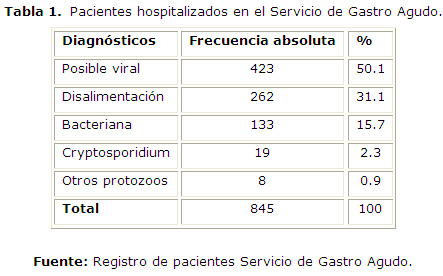Cryptosporidiosis in hospitalized infants . "Pepe Portilla" Provincial Pediatric Hospital
Keywords:
Infantile diarrhea/ethiology/prevention & control.Abstract
Introduction: cryptosporidiosis provokes acute, aqueous, non-bloody diarrheas that can be accompanied by anorexia, nausea or vomits with abdominal pain.Objective: to determine the presence of Cryptosporidium as a cause of diarrheas in pediatric patients from 1 to 2 months old hospitalized at "Pepe Portilla" Pediatric Hospital, Pinar del Rio during January-December 2010.
Material and Methods: an applied, descriptive and cross-sectional research was carried out. Percentage method was used to quantify the results. Stained feces using modified Ziehl-Neelsen technique was applied to 845 infants that comprised the target group; the sample included 19 children with feces positive to Cryptosporidium.
Results: cryptosporidium was present in 19 of the patients suffering from acute diarrhea (2.3%). The majority of the cases were reported on the months of July and August, male sex was the most affected as well as infants from 1-2 months old; aqueous diarrhea was the prevailing clinical manifestation. Fifteen (15) patients received bottle feeding. Not boiling the water, the presence of vectors and overcrowding conditions were the most deficient standards of hygiene found in these homes, most frequent in urban zones. The person taking care of infants showed an adequate educational level.
Conclusions: cryptosporidium is part of the etiology of diarrheas in hospitalized infants, preventive measures are still insufficient.
Downloads
References
1. Corrales Fuentes L, Hernández García S, Rodríguez Arencibia MA, Hernández Pérez A. Parasitismo intestinal infantil: factores epidemiológicos en Orange Walk, Belice. Rev Ciencias Médicas. [Internet]. 2011 Dic [citado 2012 Feb 17]; 15(4): [Aprox. 15p.]. Disponible en: http://scielo.sld.cu/scielo.php?script=sci_arttext&pid=S1561-31942011000400015&lng=es
2. Gatei W, Wamae CN, Mbae C. Criptosporidiosis: prevalence, genotype analysis, and symptoms associated with infections in children in Kenya. Am J Tro Me Hy. [Internet] 2006 jul [Citado el 23 de agosto del 2010]; 75 (1): [Aprox. 8 p.]. Disponible en: http://www.ajtmh.org/content/75/1/78.long
3. Meamar AR, Rezaian M, Mohraz M, Hadighi R, Kia EB. Concomitant severe infection with Cryptosporidium parvum and Hymenolepis nana in an AIDS patient. Indian J Med Sci. [Internet]. 2007 [Citado el 8 de mayo del 2010]; 61(7): [Aprox. 1 p.]. Disponible en: http://www.indianjmedsci.org/article.asp?issn=0019-5359;year=2007;volume=61;issue=7;spage=418;epage=419;aulast=Meamar
4. Chalmers RM, Elwin K, Thomas AL, Guy EC, Mason B. Long-term Cryptosporidium typing reveals the aetiology and species-specific epidemiology of human cryptosporidiosis in England and Wales, 2000 to 2003. EuroSurveillance. [Internet]. 2009 [Citado el 8 de mayo del 2010]; 14(2): [Aprox. 9 p.]. Disponible en: http://www.eurosurveillance.org/ViewArticle.aspx?ArticleId=19086
5. Centers for Disease Control and Prevention. Criptosporidiosis. 2009.
6. Cermeno J, Arenas Jl, YorI N. Cryptosporidium parvum y Giardia lamblia en aguas crudas y tratadas del estado Bolívar, Venezuela. uct. [Internet]. 2008 ene. [Citado el 14 de Noviembre del 2010]; 12(46): [Aprox. 9 p.]. Disponible en: http://www.scielo.org.ve/scielo.php?script=sci_arttext&pid=S1316-48212008000100006&lng=es&nrm=iso
7. Cuba IPK. Cryptosporidium, adquisición en piscinas y playas. 2008: BOLIPK. [Internet]. 2008 [Citado el 3 de marzo del 2010]; 18(20): [Aprox. 9 p.]. Disponible en: http://files.sld.cu/ipk/files/2010/03/bol20-08.pdf
8. Bazabe Márquez MI, Blanco Cruz G, Wildt D, López B. Perfil de la diarrea aguda en niños hospitalizados de Santa Bárbara. Rev Med Hondur. [Internet]. 2009 [Citado el 23 de junio del 2009]; 77(3): [Aprox. 19 p.]. Disponible en: http://www.bvs.hn/RMH/pdf/2009/pdf/Vol77-3-2009-4.pdf
9. Riverón Corteguera RL. Agentes parasitarios. En: Riverón Corteguera RL, Mena Miranda VR, Guzmán Rodríguez E, Guzmán Rubín E, Fernández Riveros F, Castro Pacheco BL. Pediatría. t-2. La Habana: Editorial Ciencias Médicas; 2008. p.518- 30.
10. Busto Aguiar R. Morbilidad por enfermedad diarreica aguda en lactantes contra lactancia materna. Rev Médica Electron . [Internet] 2007 nov-dic [Citado el 23 de junio del 2010]; 29(6): [aprox. 8 p.]. Disponible en: http://www.revmatanzas.sld.cu/revista%20medica/ano%202007/vol6%202007/tema05.htm
11. Carreño M, Velasco CA, Rueda E. Prevalencia de Cryptosporidium spp en niños menores de 13 años con afecciones oncológicas. Colombia Médica. [Internet]. 2005 abr-jul. [Citado el 4 de mayo del 2006]; 36(2 Supl 1): [Aprox. 8p.]. Disponible en: http://www.redalyc.org/src/inicio/ArtPdfRed.jsp?iCve=28310003
12. Castillo R, Gilman R, Miranda E, Echevarria M, Lembcke J, Sterling Ch. Secretory iga antibodies breast milk protected against infection by Cryptosporidium parvum. Parasitol. [Internet]. 2001 ene. [Citado el 25 de noviembre del 2010]; 25(1-2): [Aprox. 7 p.]. Disponible en: http://www.scielo.cl/scielo.php?script=sci_arttext&pid=S0716-07202001000100001&lng=es

Published
How to Cite
Issue
Section
License
Authors who have publications with this journal agree to the following terms: Authors will retain their copyrights and grant the journal the right of first publication of their work, which will be publication of their work, which will be simultaneously subject to the Creative Commons Attribution License (CC-BY-NC 4.0) that allows third parties to share the work as long as its author and first publication in this journal are indicated.
Authors may adopt other non-exclusive license agreements for distribution of the published version of the work (e.g.: deposit it in an institutional telematic archive or publish it in a volume). Likewise, and according to the recommendations of the Medical Sciences Editorial (ECIMED), authors must declare in each article their contribution according to the CRediT taxonomy (contributor roles). This taxonomy includes 14 roles, which can be used to represent the tasks typically performed by contributors in scientific academic production. It should be consulted in monograph) whenever initial publication in this journal is indicated. Authors are allowed and encouraged to disseminate their work through the Internet (e.g., in institutional telematic archives or on their web page) before and during the submission process, which may produce interesting exchanges and increase citations of the published work. (See The effect of open access). https://casrai.org/credit/


